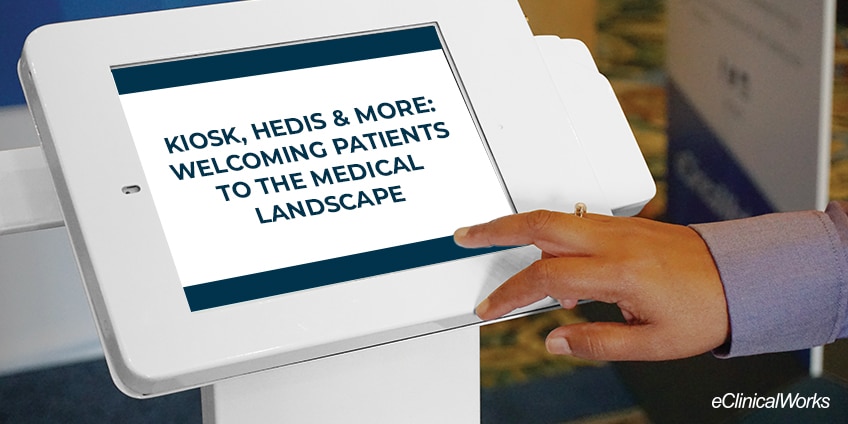Kiosk, HEDIS, and More: Welcoming Patients to the Medical Landscape
- 1 December 2020
- Blog
eClinicalWorks

A first point of contact that helps practices, too
Centuries ago, the Ottoman emperors introduced the kiosk as a small, domed pavilion or summer house that welcomed visitors to a view of wonderful gardens. Kiosks have changed over the years, but the eClinicalWorks® Kiosk still serves as a place to welcome visitors — in this case patients coming to see their doctor.
And like the kiosks of old, eClinicalWorks Kiosk gives patients a view of the medical landscape— the name of the provider they are seeing, the reason for their visit, their insurance coverage, whether a copay is due, and options for paying.
Savvy practices also recognize that using technology to save time on front office operations means more time to deploy additional healthcare IT at the practice, including risk assessment tools and analytics.
Flexible uses for Kiosk technology
For diverse, multispecialty practices such as Allied Physicians of Michiana, a partner of Indiana’s South Bend Clinic, Kiosk is an essential “first step” tool for achieving efficiency within the practice — while providing busy patients with the convenience they want and expect.
“Every single one of our practices uses the Kiosk,” said Michelle Hurtt, Senior Application Analyst. “I would say that they all use them for different purposes, but they are used at every single practice. Our urology practices uses that to speed up their check-in at the front, and pay copays and verify all their information. At our ortho practice, they use the Kiosk more to help with the clinical side of things, patients filling out questionnaires, so that information can flow right into their Progress Note.”
Hurtt said that providers love the Kiosk because it saves staff from having to transcribe patient information, and patients appreciate not having to fill out paperwork by hand.
“The back office is so excited,” Hurtt said, “they feel like they’ve just won the lottery, because that patient did it and they saved all that time that goes right to where they need to go. It’s interesting to see the different ways that the practices use it, but overall, everyone just loves Kiosk.”
Focusing on HEDIS and eBO® reporting
With Kiosk helping speed operations in the front office, Hurtt has been able to focus on implementing additional solutions throughout the practice. One of the primary tools has been the use of Healthcare Effectiveness Data and Information Set (HEDIS®)* measures in conjunction with eClinicalMessenger® campaigns.

Previously, the practice would send letters to patients who were overdue for wellness exams, but that process was labor-intensive, mostly ineffective, and left the practice with no easy way to track results. By the end of each calendar year, the practice found they had a long list of patients to call.
Now, the HEDIS dashboard makes identifying and targeting patients much easier. Hurtt can perform those tasks herself, taking another burden off member practices.
Using eBO to track results
“After I send that message out, I have an eBO report that I run to show me any patients that have scheduled appointments,” Hurtt said, adding she could then track groups of patients to determine whether the Messenger campaigns were yielding results.
“It’s amazing how effective it was,” she said. “In the very beginning, I would send out my campaign message and almost immediately I’d run my eBO report. I’d see, OK, this person received a message at 10 o’clock, and they scheduled an appointment at 10:07. I mean, it’s amazing to see how quick the response was. Everyone was just blown away at how much that has impacted everything.”
From Kiosk to eClinicalMessenger to eBO reporting, Allied Physicians of Michiana is showing how an interconnected system of healthcare IT is improving outcomes and helping to control costs.
*HEDIS is a registered trademark of the National Committee for Quality Assurance (NCQA).








